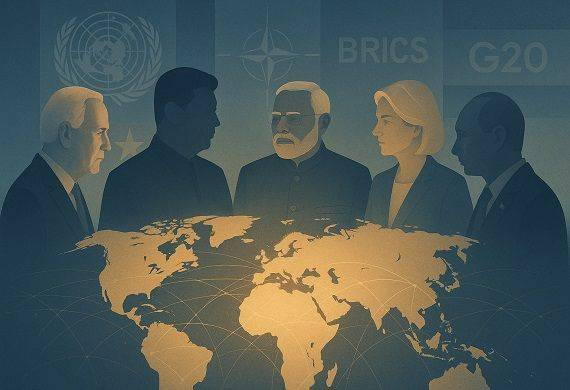How tariffs impact AI investment
By Global Leaders Insights Team | May 10, 2025

US tech giants are continuing to ramp up their spending on artificial intelligence, despite the uncertainty of tariff policies, says Eric Sheridan, co-business unit leader of the Technology, Media, and Telecommunications Group at Goldman Sachs Research. “We think they're unlikely to change because of the macro environment because [the spending is] aimed at multiyear themes,” Sheridan tells Allison Nathan, senior strategist at Goldman Sachs Research, and George Lee, co-head of the Goldman Sachs Global Institute, on this week's episode of the Exchanges podcast.
On their latest earnings calls, tech company executives have indicated that they're not yet willing to cut “long-duration investments” due to the macro environment, Sheridan says. He points out that many companies that reduced such capital investments during the global financial crisis later regretted their decisions. “I think the macro will end up with more volatility on operating expenses,” he says. “But given the sheer number of players investing both offensively and defensively in AI, I think this spend will get protected for a little longer than the macro environment might influence it.”
The Key Number: 6,000,000,000,000 RMB
China is expected to boost net government spending by 6 trillion RMB ($830 billion) this year to counter the economic impact of higher US tariffs. Despite these measures, our economists have lowered their 2025 and 2026 real GDP growth forecasts by 0.5 percentage points each, to 4% and 3.5%, respectively.
“We caution that these easing measures are unlikely to be sufficient to fully offset external shocks if the current elevated US tariff rates remain in place,” Hui Shan, Goldman Sachs' chief China economist, writes in Goldman Sachs Research's recent Top of Mind report.
After several rounds of escalation, and the temporary exemption of some consumer electronics from reciprocal tariffs, the US effective tariff rate on imports from China stands at 107% versus the 144% effective rate China has placed on US imports.
Private credit's outlook amid rising volatility
Private credit can be a defensive asset class for investors' portfolios, offering stability when uncertainty is increasing in the markets and the economy, according to James Reynolds, co-head of private credit for Goldman Sachs Asset Management.
The regular cash distributions that flow to investors can help make private credit funds attractive when other assets may appear more vulnerable, Reynolds says on a Goldman Sachs Exchanges podcast. Investors “see private credit as being a good hedge against potential inflation as well, given that most of what we do when we lend to a borrower is exposed to a floating rate.”
Private credit loan portfolios tend to be relatively defensive, Reynolds adds. Lenders in the private markets are less likely to make loans to cyclical companies that are often more heavily impacted during volatile periods. There is less exposure to commodities in private credit than there is in the public high yield market, for example. And while private credit mostly lends to smaller, middle market companies, they are not of lower quality.
A lot of private credit investing is focused on market leaders with pricing power and strong cash flows, Reynolds says. At Goldman Sachs, this includes software services, certain parts of the healthcare industry, and other businesses that may be more insulated against a downturn.
The case for European stocks
European equities could continue to outperform their American counterparts, according to Sharon Bell, senior strategist on the European Portfolio Strategy team in Goldman Sachs Research.
So far this year, the Europe STOXX 600 has risen while the S&P 500 is down — marking a significant break from years of European underperformance.
According to Bell, “there are good reasons for the switch.”
She notes that European fiscal spending is rising, which could be positive for economic growth. Meanwhile, the mega-cap US tech stocks that powered much of the S&P 500's recent rally have recently come under pressure.
Another factor is US tariffs, which Bell says are “bad for Europe, but probably worse for the US.” She explains that while they could drive down trade and growth around the world, they are likely to push up inflation in the US, and may not have the same effect in Europe.
Looking at equity markets specifically, Bell notes that valuations are also much lower in Europe, including after adjusting for America's higher proportion of tech stocks, and even after adjusting for differences in the economic growth outlook.
Bell also points out that “net flows into European stocks have been flat over the last five years — while around about $700 billion has gone into US stocks.”
“We're not saying European equities will be immune to a potential economic downturn,” Bell says. “But there is simply a lot less enthusiasm already priced in.”
Europe's major currencies have strengthened against the US dollar this year. This shift is driven by a worsening US economic outlook, which has led to a re-evaluation of the return and risk prospects of US assets, as well as more optimism about Europe as an investment destination.
Kamakshya Trivedi, head of Global Foreign Exchange, Interest Rates, and Emerging Markets Strategy Research at Goldman Sachs, highlights that this trend is likely to continue. The euro is forecast to reach $1.20 and the pound is projected to reach $1.39 in 12 months, up from $1.13 and $1.33 currently (as of May 9).
As policy uncertainty and trade tensions cause the economic outlook in the US to deteriorate, investors seem to be questioning the US exceptionalism theme that has driven strong equity returns and has made US bonds an attractive hedge for private sector portfolios.
Meanwhile, a more optimistic view of European economic growth, due in part to expectations of higher fiscal spending, is reinforcing Europe's relative appeal to investors.
German and UK government bonds outperformed Treasuries as hedges through the month of April.
Trivedi believes there's room for further realignment as investors further diversify portfolios, raising exposure to European and UK assets relative to their US holdings.
.jpg)



